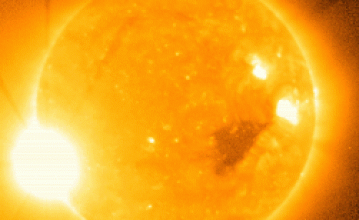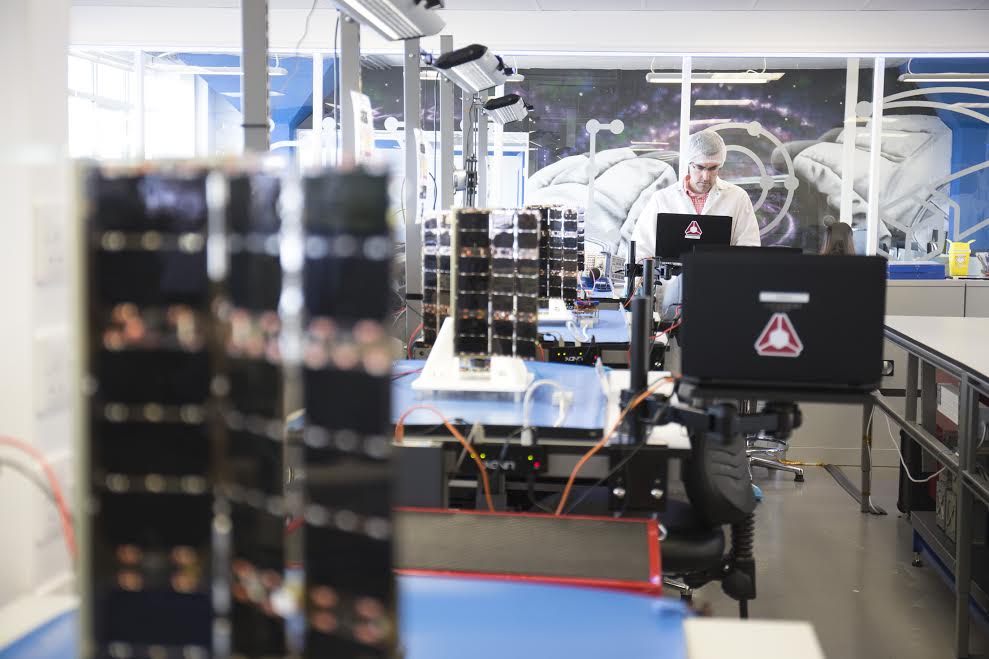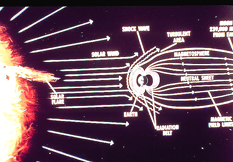 Dr. Genene Fisher
Dr. Genene FisherOn any given day — especially cloudy winter days — most people may not give a lot of thought to the Sun.
More than 150 million kilometers (93.2 million miles) away, its remoteness belies the enormous forces at work in this yellow dwarf star with a mass 330,000 times that of Earth. If someone asked us to name its harmful effects, we might come up with sunburn, heat stroke, skin cancer.
But many in the GNSS community know better.
On any given day — especially cloudy winter days — most people may not give a lot of thought to the Sun.
More than 150 million kilometers (93.2 million miles) away, its remoteness belies the enormous forces at work in this yellow dwarf star with a mass 330,000 times that of Earth. If someone asked us to name its harmful effects, we might come up with sunburn, heat stroke, skin cancer.
But many in the GNSS community know better.
Every second, the Sun fuses 620 million metric tons of hydrogen into helium — a far-from-placid process that waxes and wanes in solar cycles roughly 11 years long.
As the sun enters a period of increased activity it produces sunspots, solar flares, and coronal mass ejections (CMEs) — bursts of charged particles and magnetic field that stream out from the sun at more than one million miles an hour. These phenomena travel to the Earth where they can create profound effects: radio bursts, geomagnetic storms, and colorful auroras.
Like its planetary counterpart, space weather can have widespread and damaging impacts on human activity. The so-called Carrington Event of 1859, for example, caused telegraph systems worldwide to go haywire. Operators reported sparks from their telegraphs and sections of wire were seen to catch on fire. Even when telegraphers disconnected the batteries, aurora-induced electric currents in the wires still allowed messages to be transmitted.
Although it’s unknown when the next Carrington-level storm may occur, the space weather community does agree that the effects of such an event would be crippling to our critical infrastructure today, including GNSS.
The current solar cycle — the 24th since 1755, when recording of sunspot activity began — is expected to reach its peak, the so-called solar max, in May 2013.
Three space weather phenomena account for most GNSS errors: total electron content (TEC)–induced delays, scintillation, and solar bursts.
As GPS signals propagate through the ionosphere, the speed and direction of the GPS signal are changed in proportion to the varying electron density or TEC along the line of sight between the receiver and the satellite. This in turn affects the GPS range observable:a delay is added to the code measurements and an advance to the phase measurements.
When a radio wave crosses through the ionosphere, it results in a distortion of phase and amplitude. These fluctuations are called scintillation and create rapid variations in signal power, reducing the received power and phase coherence of the GNSS signals, which can cause a loss of lock on the signal.
Solar radio bursts begin with a solar flare that injects high-energy electrons into the solar upper atmosphere.Radio waves are produced, which propagate to Earth and cover a broad frequency range, acting as RF noise that can degrade GNSS signals.
Since the last solar maximum in 2001, societal dependence on GNSS has increased substantially. This situation has brought increasing attention to the subject of space weather and its effects on GNSS systems and users.
To help us explore the subject further, we called on Dr. Genene Fisher, now senior policy advisor with NOAA’s National Weather Service. With a doctorate in atmospheric and space sciences from the University of Michigan, Dr. Fisher served as a policy Fellow for the American Meteorological Society’s Atmospheric Policy Program for more than 10 years.
In 2010 she helped organize an AMS workshop on the subject, editing a report on the discussions there that was published last March: Satellite Navigation & Space Weather: Understanding the Vulnerability & Building Resilience.
IGM: Some research suggests that the current solar cycle will be the least active of those that have occurred for more than 100 years. Does that mean GNSS users and manufacturers don’t need to worry about space weather in the near future?
FISHER: GNSS users and manufacturers need to be concerned about space weather. The next sunspot maximum, currently predicted for May 2013, is expected to be a relatively weak maximum in terms of sunspot number. However, many of the most intense solar storms have occurred during below-average solar cycles.
Moreover, the underlying processes driving the solar cycle are still not fully understood, and any projections of the size of the next solar cycle, even this one, carry a great deal of uncertainty.
The 1859 Carrington Event, which was the largest solar flare recorded, actually took place during a less than average solar cycle.
The current solar cycle will fully test for the first time much of the GPS-based technology installed since the last solar maximum. So, GNSS users cannot rely on the last solar cycle as an indication of what may happen during future years.
IGM: What can GNSS service providers do to mitigate the effects of space weather on users?
FISHER: Companies that offer services to a broad user base should be integrating space weather products into their operations. Currently, NOAA’s Space Weather Prediction Center (SWPC) offers several products to assist GNSS users, including nowcasts of space weather conditions over North America. SWPC products include near real-time total electron content (US-TEC), designed to estimate the signal delay for single- and dual-frequency GPS applications, updated every 15 minutes.
SWPC also provides the planetary K-index plot, showing the occurrence of any magnetic field disturbances during the previous 72 hours. SWPC’s space weather scales describe conditions on a scale from 1 (minor) to 5 (extreme). For a geomagnetic storm (G3), SWPC alerts users to such effects as intermittent satellite navigation problems, including loss-of-lock and increased range errors.
For a G4 storm, satellite navigation may be degraded or inoperable for hours, and under G5 conditions GNSS signals may be degraded or unavailable for days.
The full inventory of SWPC services and products can be found online at www.spaceweather.gov. By using these products, and others available from commercial space weather providers, users can take mitigating actions.
IGM: Which improvements in space weather prediction activities and products seem to offer the greatest cost/benefit value?
FISHER: The NOAA/SWPC recently transitioned the WSA-ENLIL model, the first large-scale, physics-based space weather prediction model that provides forecasts of the solar wind structures and CMEs. Magnetic storms can occur on Earth 1–4 days after a CME erupts from the Sun. Before development of this model, forecasters could predict timing of such impacts within a 30-hour window, on average.
The new model allows forecasters to narrow that window to 12 hours. Oil drilling, mining, surveying, aviation, and other operations that rely on GPS equipment – which can be made unreliable by space weather – can avoid conditions that might put operators at risk.
IGM: Traditionally, GNSS operators and receiver manufacturers incorporate ionospheric models into the design of their systems and product. How can these models be improved and incorporated into GNSS equipment specifications?
FISHER: GNSS equipment manufacturers are using ionospheric models to make their receivers “solar max proof.” But much of the limitations of receivers is based on the current knowledge of space weather. Many of the models are climatology-based with crude, broad measure assimilation schemes. It will require much better real-time assimilation to capture the true temporal and spatial nature of the ionospheric disturbances.
As the research community continues to make advances in space weather and heliophysics, improved ionospheric models and receivers should be forthcoming.





